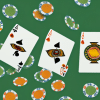If you’re looking for a fast-paced and exhilarating casino game, then look no further than craps. With over 50 different bets available on the layout, it can be a bit overwhelming for beginners. However, by understanding the most common bets made by craps players, you can increase your chances of success and have a more enjoyable gaming experience. In this article, we’ll take a closer look at some of the best bets you can make in craps and provide valuable insights into the odds and strategies that can help you win big.
Pass Line Bet: The Most Popular Craps Bet Explained
The Pass Line bet is a classic and most popular bet made in craps both at land-based casinos in South Africa and online. It’s also known as a “line bet.” The idea behind this bet is to wager on the shooter to win. There are a couple of ways to win a Pass Line bet:
- On the first roll, the shooter rolls a 7 or 11 (a “natural”).
- After establishing a point, the shooter rolls the point number again before rolling a 7.
However, Pass Line bets lose if:
- The shooter rolls a 2, 3, or 12 on the first roll (known as “craps numbers”).
- The shooter rolls a 7 before the point number is rolled again (known as “sevening out”).
The house edge on a Pass Line bet is 1.41%, meaning that the casino expects to win 1.41% of each bet you make. This is because the rules of the game favor the casino winning more bets than the player. On average, there are around 30 decisions made on the Pass Line per hour, and assuming a R5 wager, the cost per hour would be around R2.
In conclusion, the Pass Line bet is a smart bet to make for players looking for a popular and straightforward craps bet with a relatively low house edge. It’s also available for play craps online, making it accessible for players to enjoy from the comfort of their own homes.
Come Bet: A Smart Bet in Craps Explained
A come bet is a popular bet in craps that is similar to the Pass Line bet, but it’s made after the shooter establishes a point number on the come-out roll. The come bet has the same win/lose rules as the Pass Line bet. It wins if the shooter rolls a 7 or 11 on the first roll after the come bet is made, and it loses if the shooter rolls a 2, 3, or 12.
If the shooter rolls a 4, 5, 6, 8, 9, or 10, the come bet wins if the number is rolled again before a 7 appears. Conversely, it loses if the shooter throws a 7 before the number is rolled again.
The house edge for a come bet is the same as the Pass Line bet, which is 1.41%. The cost per hour is also around R2 for a $5 come bet, assuming around 30 decisions are made per hour.
In conclusion, making a come bet is a smart bet to make for players looking for an alternative to the Pass Line bet. It has the same house edge and cost per hour, making it equally favorable for players to play and enjoy the game of craps.
Odds Bet: The Best Bet in Craps Explained
The odds bet is considered the best bet in the entire casino, yet you won’t find it labeled on the craps layout. The good news is that the payout odds for a winning odds bet are equal to the probability of the bet’s winning, resulting in a house edge of zero. The bad news is that you cannot make an odds bet by itself; it must be made in conjunction with a Pass Line or Come bet.
After a point number is established on the come-out roll, smart craps players will back up their Pass Line or Come bet with an odds bet. For instance, if you wager R10 on the Pass Line, and the shooter throws a 4 as the point number on the come-out roll, you can place another R10 in chips directly behind your $10 Pass Line wager, representing the odds bet.
The shooter will continue to roll the dice until either a 4 is rolled before a 7, or a 7 is rolled before the 4. If a 4 is rolled before a 7, both the Pass Line and odds bets win. The initial R10 wager is paid at 1 to 1 (you win R10), and the R10 odds wager is paid at the true odds of making the point number, which in this case is 2 to 1, resulting in a R20 win for the initial R10 odds wager. If a 7 is rolled before the 4, then the Pass Line and odds bets are lost.
The payoff for the odds bet is the same as the true odds for the corresponding odds bet for each point number. While all casinos allow single odds, some also double, triple, ten, and up to 100-times odds. The house edge on the combined Pass Line plus odds wagers will decrease as the odds increase.
| POINT NUMBER | TRUE ODDS |
| 4 or 10 | 2 to 1 |
| 5 or 9 | 3 to 2 |
| 6 or 8 | 6 to 5 |
To take advantage of the odds bet, you should lower the amount of your Pass Line or Come bet in anticipation of making an odds bet. For example, if you wager R50 on the Pass Line, your cost would be R50 times the 1.41 percent house edge, which is 70 cents. Instead, if you decrease the Pass Line bet to $25 and place R25 on the odds, the house edge on the combined R50 wagered would be R50 times 0.85 percent, which is 42 cents. Therefore, you should always put a percentage of what you would have bet on the Pass Line or Come bet on odds. If you want to increase the amount of your next bet, add more chips to the odds wager instead of the Pass Line or Come bet. That’s the smart way to take advantage of the odds bet.
| BET | HOUSE EDGE |
| Pass Line | 1.41% |
| Pass Line + Single Odds | 0.85% |
| Pass Line + Double Odds | 0.61% |
| Pass Line + Triple Odds | 0.47% |
| Pass Line + Ten-Times Odds | 0.10% |
| Pass Line + 100-times Odds | 0.02% |
Place Bets: How to Bet on Point Numbers in Craps
A place bet is a popular craps bet that involves betting that one of the point numbers will be rolled before a seven. You can make a place bet on the 4, 5, 6, 8, 9, or 10. However, the payoffs on place bets differ from one number to another, and the house edge is different.
The following table summarizes the house edge for a place bet on each number and the cost per hour, assuming a R5 place bet (except R6 on 6 and 8 to facilitate an even dollar payoff) and 100 rolls per hour. (Note: The number of decisions per hour will vary slightly, as well: 30 for the 6 and 8, 28 for the 5 and 9, and 25 for 4 and 10.)
Number House Edge Cost per Hour
4 6.67% R2.22
5 4.00% R1.40
6 1.52% R0.91
8 1.52% R0.91
9 4.00% R1.40
10 6.67% R2.22
As you can see from the table, the lowest house edge (1.52%) and the lowest cost per hour can be achieved by making a place bet on 6 and 8. However, it’s essential to note that place bets have a higher house edge than Pass Line and Come bets, making them less favorable to play for most players.
In conclusion, if you want to make a Place bet, it’s advisable to do so only on the 6 and 8, as they have the lowest house edge and cost per hour. Nevertheless, it’s always wise to keep in mind that place bets have a higher house edge than other craps bets, so it’s essential to use them wisely and within your gambling budget.
| POINT NUMBER | TRUE ODDS | PAYOFF ODDS | HOUSE EDGE | COST PER HOUR |
| 4 or 10 | 2 to 1 | 9 to 5 | 6.67% | R8.30 |
| 5 or 9 | 3 to 2 | 7 to 5 | 4.00% | R5.60 |
| 5 or 9 | 6 to 5 | 7 to 6 | 1.52% | R2.70 |
Field Bet: A Simple but Risky Bet in Craps Explained
The field bet is a popular one-roll wager in craps due to its simplicity. After you make a field bet, it either wins if the next roll is any one of the numbers 2, 3, 4, 9, 10, 11, or 12 or loses if any of these four numbers are rolled: 5, 6, 7, or 8.
On the surface, the bet looks good since you win if any one of seven numbers is rolled and lose on only four numbers. However, the rest of the story is that the four numbers the bet doesn’t cover happen to be the ones you are most likely to roll. Moreover, the house edge for a field bet is high, ranging from 2.8% to 5.5%, depending on the payout offered by the casino.
Most casinos pay even money if a field number is rolled, but some pay double (2 to 1) on either the 2 or 12, reducing the house edge to 2.8 percent. Others pay double on either the 2 or 12 and triple on the other, lowering the house edge to 2.8 percent.
The cost per hour on a R1 Field bet (assuming 100 decisions per hour and a 12 paying 3 to 1) is R2.80. If the 12 pays 2 to 1, the cost per hour increases to R5.50. The reason the cost per hour is low for the field bet is that it’s possible to bet low amounts (e.g., R1), which is not the case when betting on the Pass Line and Come bets. If you wager more on the field, say R5, your cost per hour would be five times greater.
In conclusion, if you want to make a wager on the field, it’s advisable to do so for R1 in a casino that pays 3 to 1 for either the 2 or 12. However, keep in mind that the field bet has a high house edge and covers only a limited range of numbers, making it a risky bet for most craps players.










